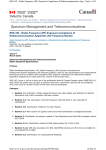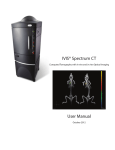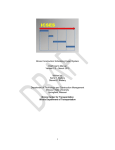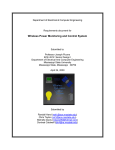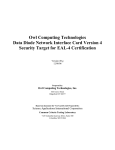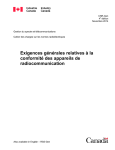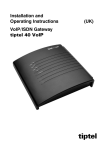Download RSS-243, Active Medical Implants Operating in the
Transcript
RSS-216 Issue 2 Month 2015 Spectrum Management and Telecommunications Radio Standards Specification Wireless Power Transfer Devices Aussi disponible en français – CNR-216 Preface This Radio Standards Specification RSS-216, Issue 2, Wireless Power Transfer Devices, replaces RSS-216 Issue 1, Wireless Power Transfer Devices (Wireless Chargers), published in September 2014. RSS-216 sets out the minimum requirements for wireless power transfer devices. This document will be in force upon its publication on the Industry Canada web site. A transition period of six months is provided, within which compliance with either RSS-216 Issue 1 or with RSS-216 Issue 2 is accepted. The transition period will end on the last day of the month (6 months after the month on the first page) 2015, after which date only compliance with RSS-216 Issue 2 will be accepted. List of Changes: 1) The title of the standard has been changed from RSS-216 Wireless Power Transfer Devices (Wireless Chargers) to RSS-216 Wireless Power Transfer Devices; 2) The content of the standard has been entirely modified. A list of main changes is provided below: The scope of RSS-216 was updated to cover all types of wireless power transfer devices (though for some an inquiry has to be submitted before applying RSS-216). Issue 2 differentiates between three types of devices based on their classification as radio apparatus (of Category I or II) or interference-causing equipment, specifically Industrial, Scientific and Medical (ISM) equipment. Added test methods and arrangements of the equipment under test, specific to wireless power transfer devices. NOTE: Normally, the RSS-200 series of standards apply to radiocommunication apparatus that are classified as Category I, as per RSS-Gen, requiring certification, and which are licence-exempt. However, RSS-216 Issue 2 differentiates between three types of wireless power transfer devices and includes requirements for all of them: ISM interference-causing equipment, Category II radio apparatus and Category I radio apparatus. The Department feels that the benefits and convenience of having all wireless power transfer devices under one Industry Canada standard (instead of one ICES, one RSS-200 series and another RSS-300 series) outweigh this exception from the normal standard numbering system. i Inquiries may be directed to the following address: Industry Canada Engineering, Planning and Standards Branch 235 Queen Street, Ottawa, Ontario, K1A 0H5, Canada Attention: Regulatory Standards Directorate Email: [email protected] Comments and suggestions for improving this standard can be submitted online using the form at http://www.ic.gc.ca/eic/site/ceb-bhst.nsf/frm-eng/EABV-9VCLQJ. All Spectrum Management and Telecommunications publications are available on the following website: http://www.ic.gc.ca/spectrum. Issued under the authority of the Minister of Industry ____________________________________ Daniel Duguay Director General Engineering, Planning and Standards Branch ii Contents 1 Scope ................................................................................................................................... 1 1.1 1.2 General .................................................................................................................................1 Types of WPT Devices ........................................................................................................1 1.2.1 Type 1 (WPT devices that are ISM equipment) .......................................................1 1.2.2 Type 2 (WPT devices that are Category II radio apparatus) ....................................1 1.2.3 Type 3 (WPT devices that are Category I radio apparatus) .....................................2 2 Normative References ....................................................................................................... 2 3 Definitions ........................................................................................................................... 2 3.1 3.2 3.3 3.4 3.5 3.6 3.7 Wireless Power Transfer (WPT) ..........................................................................................2 WPT Device .........................................................................................................................2 WPT Source .........................................................................................................................3 WPT Client ...........................................................................................................................3 Load Modulation ..................................................................................................................3 Power Transfer Management ...............................................................................................3 Secondary Frequency ...........................................................................................................3 4 Certification Requirements .............................................................................................. 3 5 Technical Requirements.................................................................................................... 4 5.1 5.2 5.3 5.4 5.5 Methods of Measurement – General Requirements .............................................................4 5.1.1 Equipment under Test (EUT) ...................................................................................4 5.1.2 EUT Setup for WPT Source Devices .......................................................................5 5.1.3 EUT Setup for WPT Client Devices ........................................................................6 5.1.4 EUT Setup for WPT Systems (source and client/clients together) ..........................7 5.1.5 Separation Distance ..................................................................................................8 5.1.6 Orientation ................................................................................................................8 5.1.7 Multiple Tests ...........................................................................................................9 5.1.8 Battery-operated WPT Source ..................................................................................9 Technical Requirements for Type 1 WPT Devices ..............................................................9 5.2.1 Instrumentation and Test Facilities ..........................................................................9 5.2.2 Methods of Measurement .........................................................................................9 5.2.3 Limits ........................................................................................................................9 Technical Requirements for Type 2 WPT Devices ............................................................10 5.3.1 Instrumentation and Test Facilities ........................................................................10 5.3.2 Methods of Measurement .......................................................................................10 5.3.3 Limits ......................................................................................................................10 Technical Requirements for Type 3 WPT Devices ............................................................10 5.4.1 Instrumentation and Test Facilities ........................................................................10 5.4.2 Methods of Measurement .......................................................................................11 5.4.3 Limits ......................................................................................................................11 Radio Frequency (RF) Exposure Compliance ...................................................................11 5.5.1 RF Exposure from Type 1 WPT Devices ...............................................................11 iii 5.5.2 RF Exposure from Type 2 WPT Devices ...............................................................11 5.5.3 RF Exposure from Type 3 WPT Devices ...............................................................12 6 Test Report ....................................................................................................................... 13 7 Labelling Requirements .................................................................................................. 13 7.1 7.2 Labelling Requirements for Type 1 and Type 2 WPT Devices .........................................13 Labelling Requirements for Type 3 WPT Devices ............................................................13 iv Wireless Power Transfer Devices 1 Scope 1.1 General RSS-216 This Radio Standards Specification (RSS) sets out the minimum requirements for wireless power transfer (WPT) devices, including sources (WPT transmitters) and clients (WPT receivers). See section 3 for the definitions of all these terms. High power WPT devices (e.g. for charging electric vehicles), devices designed for wireless power transfer over a distance greater than 10 cm and medical devices with wireless power transfer capability may require additional instructions on test setup, specific test procedure and/or technical requirements. As such, for these WPT devices, an inquiry must be submitted to the Directorate of Regulatory Standards (DRS) of Industry Canada, at [email protected], before verifying compliance with RSS-216. The inquiry shall include sufficient information on the technology and operation of the device to allow the Department to determine the applicable technical and administrative requirements for the specific device. The WPT devices under the scope of this standard are differentiated in three categories, as per the following sub-section. Wireless power transfer devices are either interference-causing equipment or licence-exempt radio apparatus and they operate on a no interference, no protection basis. Receive-only WPT client devices, i.e. WPT client devices that do not have any wireless transmitters, are excluded from the scope of this standard. No technical or administrative requirements apply to receiveonly WPT client devices under RSS-216. However, other Industry Canada standards may apply to the device, depending on its type and functionality. 1.2 Types of WPT Devices 1.2.1 Type 1 (WPT devices that are ISM equipment) Type 1 includes WPT devices that are incapable of transmitting any form of intelligent communication wirelessly (including communication related to power transfer management). Type 1 WPT devices are classified as ISM (Industrial, Scientific and Medical) devices. However, because they are intentional radiators, they may be subject to RF exposure regulation; RF exposure from equipment that is not a radio apparatus (as per the Radiocommunication Act) is regulated by Health Canada (see section 5.5.1). 1.2.2 Type 2 (WPT devices that are Category II radio apparatus) Type 2 includes all wireless power transfer devices that cannot be classified as type 1, but which meet the following two conditions: (i) Fundamental emission(s) is(are) below 490 kHz; and 1 Wireless Power Transfer Devices (ii) RSS-216 All emissions radiated by the device are demonstrated to be at least 40 dB below the general field strength limits for licence-exempt radio apparatus set out in RSS-Gen (for below 30 MHz as well as for above 30 MHz). Type 2 WPT devices are classified as Category II radio apparatus, as per RSS-Gen. 1.2.3 Type 3 (WPT devices that are Category I radio apparatus) Type 3 includes all wireless power transfer systems and devices that cannot be classified as type 1, nor as type 2. Examples of type 3 devices are: WPT devices using load modulation techniques on the power transfer frequency for communication related to power transfer management and/or to the prioritization of devices for charging, transmission of data, images, music files, etc.; WPT devices using a different frequency than the power transfer frequency for purposes such as signalling (including for power transfer management), control and/or data transfer, etc. Type 3 WPT devices are classified as Category I radio apparatus, as per RSS-Gen, and require certification. 2 Normative References The following documents are referenced in this standard and are indispensable for its application. The latest edition applies, for each normative reference. ICES-001, Industrial, Scientific and Medical (ISM) Radio Frequency Generators RSS-Gen, General Requirements for Compliance of Radio Apparatus RSS-102, Radio Frequency (RF) Exposure Compliance of Radiocommunication Apparatus (All Frequency Bands) RSS-310, Licence-exempt Radio Apparatus (All Frequency Bands): Category II Equipment RSP-100, Certification of Radio Apparatus 3 Definitions 3.1 Wireless Power Transfer (WPT) Wireless power transfer is the transfer of energy between a source and one or more client devices by means of radio waves, with no electrical contact between the source and the client devices, for the purpose of powering and/or charging the client device(s) wirelessly. 3.2 WPT Device A WPT device is an apparatus capable of wireless power transfer. A WPT device may be a WPT source, a WPT client or a system including a combination of one WPT source and one or more WPT clients. 2 Wireless Power Transfer Devices 3.3 RSS-216 WPT Source A WPT source is a device directly connected (i.e. through a wired connection) to a power source, e.g. AC mains, a battery or some other source of electrical power, and which is capable of wireless power transfer to one or more WPT client devices. 3.4 WPT Client A WPT client is a device capable of receiving power wirelessly from a WPT source. A WPT client is not designed to transmit power wirelessly, only to receive it; however, it may include intentional radiators, other than for power transfer, e.g. for power management signalling to the WPT source. 3.5 Load Modulation Load modulation is a limited communication technique between WPT sources and WPT clients that is based on load impedance changes on the client and/or source devices. The communication is performed by modulating the wireless power transfer frequency and it is limited to the sole purpose of power transfer management and control. 3.6 Power Transfer Management Power transfer management refers to the functionality of some WPT devices to exchange information related to the power transfer operation between the source and the client for purposes such as detection of invalid devices / objects, communicating status information, sending commands from the source to the client and acknowledgements from the client to the source, etc. 3.7 Secondary Frequency Secondary frequency is any frequency or channel on which a WPT device intentionally transmits radiated electromagnetic energy other than for wireless power transfer. 4 Certification Requirements Type 1 and type 2 WPT devices do not require certification. The manufacturer, importer and/or distributor shall however ensure that all type 1 and type 2 WPT systems and devices comply with all applicable standards and procedures. Type 3 WPT devices are Category I radio apparatus and require a Technical Acceptance Certificate (TAC), as per RSS-Gen. The application for certification shall follow the procedures set out in RSP-100. 3 Wireless Power Transfer Devices RSS-216 5 Technical Requirements 5.1 Methods of Measurement – General Requirements This section includes general requirements to be observed when verifying compliance with this standard. These general requirements are applicable to all three types of WPT devices, in addition to the specific requirements defined elsewhere in section 5 separately for each WPT type. 5.1.1 Equipment under Test (EUT) 5.1.1.1 WPT Source WPT source devices marketed independently shall be tested with one or more units of typical client devices, as applicable, selected such that the WPT source device is fully exercised, at maximum power from all its transmitters, including at the power transfer frequency, as per section 5.1.2. In this case, the EUT consists of the WPT source device and the WPT client device(s) is(are) auxiliary equipment. The WPT client devices used as auxiliary equipment during testing shall be compliant with this standard. 5.1.1.2 WPT Client WPT client devices marketed independently shall be tested with a typical source device, as applicable, selected such that the WPT client device is fully exercised, at maximum power from all its transmitters, as per section 5.1.3. In this case, the EUT consists of the WPT client device and the WPT source device is auxiliary equipment. The WPT source device used as auxiliary equipment during testing shall be compliant with this standard. 5.1.1.3 WPT System WPT systems consisting of one WPT source and one or more WPT clients, marketed together as a system and where neither the source nor the client(s) can operate with other types of WPT devices, shall be tested together. In this case, the EUT consists of the WPT source and the WPT client(s) together. See section 5.1.4. WPT source and client devices marketed as a system, but where the source and/or the client device(s) is/are designed such that they are capable of operating with other WPT device models, are not considered a WPT system. In this case, the WPT source and the WPT client are considered two different EUTs and they shall be tested as independent devices, as per section 5.1.1.1 and 5.1.1.2, respectively. 4 Wireless Power Transfer Devices 5.1.2 RSS-216 EUT Setup for WPT Source Devices This section applies to WPT source devices that are marketed independently (see section 5.1.1.1). 5.1.2.1 Setup for Verifying the Power Transfer Function For verifying the compliance of emissions generated from the EUT’s WPT function with the technical requirements in this standard, the EUT shall be tested with one or more typical WPT client devices of models for which it is designed. The WPT client device(s) shall be selected and both the EUT and the WPT client devices shall be operated such that the EUT transmits at the maximum output power for which it is designed on its wireless power transfer frequency (frequencies). This may be accomplished, for example, through special configuration of the EUT (e.g. by means of specific software or hardware configuration, if provided by the manufacturer) and/or by periodically interrupting the test and discharging the auxiliary WPT client device(s) before resuming the test, such that the EUT transmits at its maximum output power throughout the tests. The method used for ensuring that the EUT transmits at its maximum power shall not modify the EUT from its typical application configuration, other than for ensuring continuous maximum power transfer. The method used shall be documented in the test report. Depending on the design of the EUT, one of the following EUT setup configurations shall be used throughout the tests, as applicable: (i) Single fixed power transfer zone, single client If the EUT has only one, fixed power transfer zone and is capable of only powering/charging one client at a time, it shall be tested with a typical WPT client device for which it is designed. The model of the auxiliary WPT client device shall be selected such that the requirements for maximum power loading of the EUT specified above are satisfied. (ii) Multiple fixed power transfer zones, single client If the EUT has multiple fixed power transfer zones, but it is only capable of powering/charging one client at a time, it shall be tested with a typical WPT client device for which it is designed and the test shall be repeated with the WPT client device placed in sequence in each power transfer zone of the EUT. The model of the auxiliary WPT client device shall be selected such that the requirements for maximum power loading of the EUT specified above are satisfied. (iii) Multiple non-fixed power transfer zones, single client If the EUT has a large power transfer zone or multiple non-fixed power transfer zones, but it is capable of powering/charging only one client at a time (e.g. WPT source devices with freepositioning of the client device), it shall be tested with a typical WPT client device for which it is designed and the test shall be repeated with the WPT client device placed in sequence at the following five locations: in the centre and four locations near the boundary of the overall power transfer zone. If the EUT’s overall power transfer zone is of rectangular or square shape, the four boundary locations shall be at its four corners. Otherwise, the four boundary locations shall be approximately equally spaced around the perimeter of the EUT’s overall power transfer zone. If the EUT’s overall power transfer zone and the WPT client models accepted by the EUT are such that only a maximum of four client devices would fit within the EUT’s power transfer zone at the same time, a reduced number of test locations is acceptable. However, in this case, the test locations and their number shall be selected such that the entire EUT’s overall power transfer zone would be covered if WPT client devices would be placed on all test 5 Wireless Power Transfer Devices RSS-216 locations at the same time. The model of the auxiliary WPT client device shall be selected such that the requirements for maximum power loading of the EUT specified above are satisfied. (iv) Multiple power transfer zones, multiple clients If the EUT has a large power transfer zone or multiple fixed or non-fixed power transfer zones and is capable of powering/charging multiple clients simultaneously, it shall be tested with multiple WPT client devices of types / models for which it is designed. If the number of client devices selected for satisfying the EUT maximum output power requirement does not completely cover the overall power transfer surface area of the EUT, the test shall be repeated with different placement configurations of the client devices such that each of the locations described at (ii) or (iii) above, as applicable (based on the EUT design), is included in at least one test configuration. If more than one test is required, the EUT must comply with this standard in all tested configurations. 5.1.2.2 Setup for Verifying the Secondary Frequencies For verifying the compliance of emissions generated from secondary frequencies (see definition in section 3.7) with the technical requirements in this standard, the EUT shall be tested with one or more typical WPT client devices of model(s) for which it is designed. The WPT client device(s) shall be selected and both the EUT and the WPT client device(s) shall be configured such that the EUT transmits at maximum power on all its secondary frequencies. This may be accomplished, for example, through special configuration of the EUT and/or of the auxiliary WPT client device(s) by means of specific software or hardware configuration, if provided by the manufacturer. If the EUT cannot transmit simultaneously at maximum power on all secondary frequencies in normal operation, the test shall be repeated for a number of typical combinations of secondary frequencies that can transmit at the same time such that all secondary frequencies are verified for compliance with this standard. The method used for ensuring the EUT transmits at its maximum power shall not modify the EUT from its typical application configuration, other than for ensuring continuous transmission at maximum power. The method used shall be documented in the test report. If more than one test is required, the EUT must comply with this standard in all tested configurations. 5.1.3 EUT Setup for WPT Client Devices This section applies to WPT client devices that are marketed independently (see section 5.1.1.2). NOTE: Only WPT client devices with secondary frequencies are subject to this standard. Receive-only WPT client devices are deemed to comply with this standard without testing (see section 1.1). The EUT shall be tested together with a typical WPT source device for which the EUT is designed. The selected WPT source shall be capable of exercising all secondary frequency transmitters (see definition in section 3.7) of the EUT, at their maximum transmission power. While verifying compliance with this standard the WPT client device shall be operated such that it transmits at maximum power on all secondary frequencies. This may be accomplished, for example, through special configuration of the EUT and/or of the auxiliary WPT source device (e.g. by means of specific software or hardware configuration, if provided by the manufacturer). 6 Wireless Power Transfer Devices RSS-216 If the EUT cannot transmit simultaneously at maximum power on all secondary frequencies in normal operation, the test shall be repeated for a number of typical combinations of secondary frequencies that can transmit at the same time such that all secondary frequencies are verified for compliance with this standard. The method used for ensuring the EUT transmits at its maximum power shall not modify the EUT from its typical application configuration, other than for ensuring continuous transmission at maximum power. The method used shall be documented in the test report. If more than one test is required, the EUT must comply with this standard in all tested configurations. 5.1.4 EUT Setup for WPT Systems (source and client/clients together) This section applies to WPT systems where the source and client devices are marketed together as a system and where neither the source nor the client(s) are intended to operate with other models of WPT devices (see section 5.1.1.3). WPT source and client devices marketed as a system, but where the source and/or the client device(s) is(are) designed such that they are capable of operating with other WPT device models, are not considered a WPT system. In this case, the WPT source and the WPT client(s) are to be treated as different EUTs and they shall be tested as independent devices, per the requirements in 5.1.2 and 5.1.3, respectively. 5.1.4.1 Setup for Verifying the Power Transfer Function For verifying the compliance of emissions generated from the EUT’s WPT function with the technical requirements in this standard, the EUT shall be tested with one or more WPT client devices, as applicable based on the EUT design. The WPT client device(s) shall be selected and both the WPT source and WPT client devices shall be operated such that the EUT’s WPT source transmits at the maximum output power for which it is designed on its wireless power transfer frequency (frequencies). This may be accomplished, for example, through special configuration of the EUT (e.g. by means of specific software or hardware configuration, if provided by the manufacturer) and/or by periodically stopping the test and fully discharging the client device(s) before resuming the test, such that the EUT`s WPT source transmits at its maximum output power throughout the tests. The method used for ensuring that the EUT’s source device transmits at its maximum power shall not modify the EUT from its typical application configuration, other than for ensuring continuous maximum power transfer. The method used shall be documented in the test report. Depending on the design of the EUT, the setup configuration used throughout the tests shall comply with the requirements described in 5.1.2.1 (i), (ii), (iii) or (iv), as applicable. If more than one test is required, the EUT must comply with this standard in all tested configurations. 5.1.4.2 Setup for Verifying the Secondary Frequencies For verifying the compliance of emissions generated from secondary frequencies (see definition in section 3.7) with the technical requirements in this standard, the EUT shall be configured with its WPT source and at least one WPT client device such that both its WPT source and its WPT client(s) transmit at maximum power on all their secondary frequencies. This may be accomplished, for example, through special configuration of the EUT (e.g. by means of specific software or hardware configuration, if provided by the manufacturer). 7 Wireless Power Transfer Devices RSS-216 The WPT client(s) used for testing shall be selected as follows: If the EUT includes only receive-only WPT client devices (with no secondary frequency transmitters), any of these can be selected for testing as long as the EUT can be configured such that its WPT source transmits at maximum power on all its secondary frequencies; If the EUT includes only WPT clients with secondary frequencies, at least one of each model of WPT client device shall be included in the test; If the EUT includes a number of WPT clients of different models, of which only some have secondary frequency transmitters, at least one of each model of the latter shall be included in the test. If the EUT cannot transmit simultaneously at maximum power on all secondary frequencies in normal operation, the test shall be repeated for a number of typical combinations of secondary frequencies that can transmit at the same time such that all secondary frequencies in both the WPT source and in each model of WPT client are verified for compliance with this standard. The method used for ensuring that the EUT transmits at its maximum power shall not modify the EUT from its typical application configuration, other than for ensuring continuous transmission at maximum power. The method used shall be documented in the test report. If more than one test is required, the EUT must comply with this standard in all tested configurations. 5.1.5 Separation Distance This section applies to all EUTs that are capable of wireless power transfer over a non-zero separation distance between the source and the client devices. For these EUTs, preliminary exploratory measurements shall be performed by varying the WPT client(s) orientation and separation distance from the wireless power transfer zone of the WPT source, within the limits allowed for by the WPT system under test (as per the manufacturer’s instructions specified in the user manual and/or in the technical specification), for finding the configuration that generates the highest levels of emissions. The final compliance measurements shall then be carried out on the worstcase EUT configuration. This procedure shall be employed for all EUT emissions. Alternatively, the EUT shall be tested in at least the following two configurations: With zero separation between the source and the client devices; With maximum separation between the source and the client devices. 5.1.6 Orientation The WPT devices subject to this standard shall be tested in their typical setup configuration, as per the manufacturer’s instructions in the user manual. If the source device can be operated in various orientations (e.g. tabletop and wall-mount), it shall be tested in each orientation in which it is likely to be used. For wall-mounted operation, the device shall be placed on the test table (80 cm high, for radiated emissions; 80 or 40 cm high for conducted emissions, if a vertical reference place is used or not used, 8 Wireless Power Transfer Devices RSS-216 respectively) and it shall be vertically set up, in a similar way as in its intended application. Any support used to hold the device in vertical position on the test table shall be made of insulating materials that are transparent and not reflective to the electromagnetic energy at all frequencies within the tested frequency range. 5.1.7 Multiple Tests Wherever this standard requires a test case to be repeated for a number of specific EUT configurations, it is acceptable to perform initial pre-scan investigations to determine the configuration generating worst-case emissions and only perform the final measurement on the worst-case configuration. However, in this case, all pre-scan results and a description of the preliminary investigation, including photographs of the various test configurations, shall be included in the test report, together with the final measurements. This process is not applicable to secondary frequencies (each type of secondary frequency must be tested against the applicable requirements in the corresponding RSS). 5.1.8 Battery-operated WPT Source The conducted emissions requirements do not apply to WPT source devices that are exclusively powered from a battery. WPT source devices indirectly powered from the AC mains power network shall be tested together with their AC mains power adapter, if included with the WPT source device, or with a typical power adapter (as per the manufacturer’s recommendation). WPT source devices powered from a battery, but which include the capability to also operate while powered from an external AC mains power adapter, shall be tested as an AC mains powered device. 5.2 Technical Requirements for Type 1 WPT Devices This section applies to type 1 WPT devices, as defined in section 1.2.1. In addition to the technical requirements set out in this section, see also section 5.5.1, for applicability of RF exposure requirements. 5.2.1 Instrumentation and Test Facilities The instrumentation and test facilities used to demonstrate compliance of type 1 WPT devices with the limits defined in this section shall be in accordance with the requirements set out in ICES-001. 5.2.2 Methods of Measurement The measurement methods used to demonstrate compliance of type 1 WPT devices with the limits defined in this section shall be in accordance with ICES-001. The additional EUT test setup and measurement method requirements set out in section 5.1 also apply. 5.2.3 Limits 5.2.3.1 Conducted Emissions Type 1 WPT devices shall comply with the mains terminals disturbance voltage limits for induction cooking (group 2) equipment, as set out in the CISPR 11 standard referenced in ICES-001. 9 Wireless Power Transfer Devices RSS-216 5.2.3.2 Radiated Emissions The magnetic field radiated emissions within 9 kHz – 30 MHz from type 1 WPT devices shall comply with the limits for induction cooking (group 2) equipment, as set out in the CISPR 11 standard referenced in ICES-001. The electric field radiated emissions within 30 – 1000 MHz from type 1 WPT devices shall comply with the limits for group 2 equipment, as set out in the CISPR 11 standard referenced in ICES-001. The group 2 Class B limits apply, unless it can be demonstrated that the WPT device / system is not intended and very unlikely to be used in a residential environment, including a home business, in which case the group 2 Class A limits can be used. 5.3 Technical Requirements for Type 2 WPT Devices This section applies to type 2 WPT devices, as defined in section 1.2.2. 5.3.1 Instrumentation and Test Facilities The instrumentation and test facilities used to demonstrate compliance of type 2 WPT devices with the limits defined in this section shall be in accordance with the requirements set out in RSS-Gen. 5.3.2 Methods of Measurement The measurement methods used to demonstrate compliance of type 2 WPT devices with the limits defined in this section shall be in accordance with RSS-Gen. The additional EUT test setup and measurement method requirements set out in section 5.1 also apply. 5.3.3 Limits Type 2 WPT devices shall comply with RSS-Gen and with section 3.7 of RSS-310. 5.4 Technical Requirements for Type 3 WPT Devices This section applies to type 3 WPT devices, as defined in section 1.2.3. In addition to the technical requirements set out in this section, see also section 5.5.3, for applicability of RF exposure requirements. 5.4.1 Instrumentation and Test Facilities The instrumentation and test facilities used to demonstrate compliance of type 3 WPT devices with the limits defined in this section shall be in accordance with the requirements set out in RSS-Gen and the other RSS(s), as applicable to the wireless technology used in the device. 10 Wireless Power Transfer Devices 5.4.2 RSS-216 Methods of Measurement The measurement methods used to demonstrate compliance of type 3 WPT devices with the limits defined in this section shall be in accordance with RSS-Gen and the other RSS(s), as applicable to the specific wireless technology(-ies) used in the device. The additional EUT test setup and measurement method requirements set out in section 5.1 also apply. 5.4.3 Limits Type 3 WPT devices are Category I radio apparatus and require certification, as per RSS-Gen (see section 2). Type 3 WPT devices shall comply with RSS-Gen and with the other RSS(s) applicable to the specific wireless technology(-ies) used in the device. 5.5 Radio Frequency (RF) Exposure Compliance 5.5.1 RF Exposure from Type 1 WPT Devices Type 1 WPT devices are interference-causing equipment and, as such, even though they intentionally transmit radiated electromagnetic energy, they fall out of the scope of RSS-102. RF exposure from equipment other than radio apparatus is regulated by Health Canada, as per their mandate under the Radiation Emitting Devices Act and the Radiation Emitting Devices Regulations. The manufacturer or importer of a type 1 WPT device must contact Health Canada’s Consumer and Clinical Radiation Protection Bureau for determining if additional technical and administrative requirements, in addition to RSS-216, apply before placing the specific model of device on the Canadian marketplace. Health Canada’s Consumer and Clinical Radiation Protection Bureau can be contacted using the online inquiry form at http://www.hc-sc.gc.ca/contact/ewh-semt/hecs-dgsesc/ccrp-prpcc-eng.php or through email, at [email protected]. 5.5.2 RF Exposure from Type 2 WPT Devices Type 2 WPT devices are exempt from an RF exposure and/or Specific Absorption Rate (SAR) routine evaluation as set forth in RSS-102. However, this exemption from routine evaluation is not an exemption from compliance with Health Canada’s Safety Code 6 limits, as set forth in RSS-102. 11 Wireless Power Transfer Devices 5.5.3 RSS-216 RF Exposure from Type 3 WPT Devices All type 3 WPT devices, except for those meeting all the conditions in the following paragraph, shall comply with the applicable requirements of RSS-102. Inductive WPT devices with no secondary intentional radiating frequencies meeting all of the following conditions are exempted from RF exposure and/or SAR routine evaluation as set forth in RSS-102. However, this exemption from routine evaluation is not an exemption from compliance with Health Canada’s Safety Code 6 limits, as set forth in RSS-102. The conditions for exemption from routine evaluation are: (i) Wireless power transfer frequency is below 1 MHz; (ii) Output power from each primary coil (i.e. transmitter coil, in the WPT source device) is less than 5 W; (iii) The WPT device is only capable of wireless power transfer between one source and one client at a time. This includes WPT systems having multiple primary coils (i.e. in the WPT source) as long as they only allow wireless power transfer to take place through only one pair of coils at a time (one in the source and the other in the client). It also includes WPT systems where the source may use two or more overlapping smaller coils to form a fixed charging/powering zone as long as they only allow wireless power transfer to take place between this zone and a single client device; (iv) The WPT client device is placed in direct contact with or docked onto the WPT source; (v) The maximum coupling surface area of the WPT source is less than or equal to 400 cm2; and (vi) The total leakage fields from all simultaneous transmitting coils are demonstrated to be less than 30 % of the applicable Health Canada’s Safety Code 6 limits for uncontrolled environments as set forth in RSS-102 at 10 cm from the WPT system in all directions. The total leakage fields shall be calculated or measured based on actual and typical WPT clients of types selected such that they provide worst-case conditions. In case of WPT source devices with multiple fixed power transfer zones, but capable of powering/charging only one client at a time, this requirement shall be met separately for each zone. RF exposure shall be evaluated with the client device(s) charged/powered by the source device at maximum output power. Additionally, all transmitters, including those not used for power transfer, must be active simultaneously and at maximum power. In case of WPT devices designed for desktop applications (e.g. wireless charging pads), RF exposure shall be evaluated at 10 cm away from all sides and from the top of the WPT device / system. The 10 cm shall be as measured from the probe centre to the WPT device / system edge. A combination of analytical analysis, electric and magnetic field strength measurements, SAR assessment, radiated and conducted power measurements, in conjunction with computational modeling may be required to demonstrate compliance with the RF exposure limits depending on the operating frequency of the wireless power transfer device. 12 Wireless Power Transfer Devices 6 RSS-216 Test Report The manufacturer or importer of WPT devices subject to this RSS shall ensure that compliance with all applicable technical requirements has been demonstrated and the results compiled into a proper test report. The test report shall comply with the provisions set out in ICES-001 (for type 1 WPT devices), in RSS-Gen (for type 2 and type 3 WPT devices) and in this standard (for all WPT devices), shall be retained by the manufacturer or importer for as long as the model is manufactured, imported, offered for sale, distributed and/or leased in Canada, and shall be made available to Industry Canada upon request. NOTE: The test report for type 3 WPT devices is submitted to Industry Canada (directly or through a recognized Certification Body) with the certification application, as per RSP-100. 7 Labelling Requirements 7.1 Labelling Requirements for Type 1 and Type 2 WPT Devices Each unit of a type 1 or type 2 WPT device model (as defined in sections 1.2.1 and 1.2.2, respectively) shall bear a label which represents the manufacturer’s or importer’s Self-Declaration of Compliance to Industry Canada RSS-216. This label shall be permanently affixed to the apparatus or displayed electronically as per Notice 2014 - DRS1003 and its text must be clearly legible. If the dimensions of the device are too small or if it is not practical to place the label on the apparatus and electronic labelling has not been implemented, the label shall be, upon agreement with Industry Canada, placed in a prominent location in the user manual supplied with the apparatus. The user manual may be in an electronic format, in which case it must be readily available (e.g. on the manufacturer’s web site) for as long as the model is manufactured, imported, offered for sale, distributed and/or leased in Canada. The Industry Canada compliance label shall include the word “Canada” (or “CAN”), the standard name in both English and French. For type 1 WPT devices, the label shall also include the Class under which it was verified (see section 5.2.3.2). An example is given below: CAN RSS-216 (*) / CNR-216 (*) * Insert either “A” or “B”, but not both, to identify the applicable Class of the WPT device (type 1 only). Note: The RSS-216 compliance label is not required on devices consisting of type 1 or type 2 WPT devices housed together with Category I radio apparatus, these devices being subject to the labeling requirements for Category I radio apparatus set out in RSP-100. However, it is mandatory for such type 1 or type 2 WPT devices to comply with the applicable user manual, testing and reporting requirements set out in RSS-216. 7.2 Labelling Requirements for Type 3 WPT Devices For type 3 WPT devices (as defined in section 1.2.3), the labelling requirements set out in RSP-100 apply. 13



















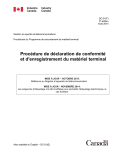
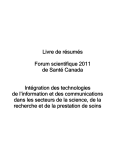

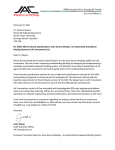
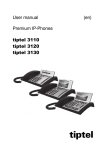
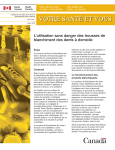

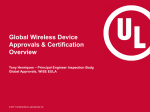

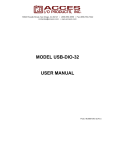

![to a copy of the presentation! [ PDF 3659 kB ]](http://vs1.manualzilla.com/store/data/005993145_1-0ef1bf04b92f9350e985abe9a695cb4d-150x150.png)
